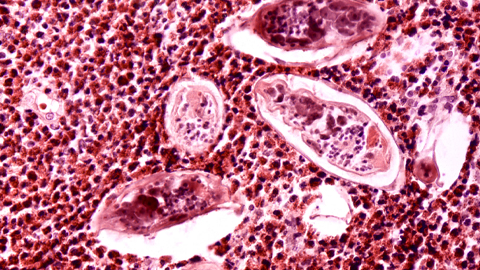New compound offers hope for deadly tropical disease
A newly developed compound is showing promise in animal studies as a more effective treatment for human schistosomiasis, an understudied tropical disease caused by parasitic worms. The spread of schistosomiasis, a disease responsible for nearly 12,000 deaths globally each year, has been documented in 78 nations.
Although schistosomiasis transmission tends to occur in tropical and subtropical areas, climate change could shift it into new areas such as southern Europe. There is currently no vaccine available for the disease, which comes with severe clinical symptoms. The drug praziquantel is used for treatment. However, resistant mutations are reducing praziquantel’s efficacy, and the drug doesn’t kill the larval-stage parasites.

Sevan N. Alwan, an assistant professor at The University of Texas Health Science Center at San Antonio, led the research team.
“The infection can become reactivated when the larva develop into adult parasites, which comes with more severe symptoms and higher transmission rates,” said Alwan, an assistant professor at The University of Texas Health Science Center at San Antonio. “The compound we developed overcomes the limitations of praziquantel by being effective against the larval stage and resistant strains.”
Alwan will present the research at Discover BMB, the annual meeting of the American Society for Biochemistry and Molecular Biology, which will be held March 23–26 in San Antonio.
“In recent reports, the cure rates for praziquantel were 60% in Sub-Saharan Africa, where the disease is highly endemic,” said Alwan. “The drug limitations strongly warrant the need for new therapeutics with a distinctly different mechanism of action to reach a better cure rate.”
The new compound was developed as part of the research team’s effort to design, synthesize and test reengineered derivatives of oxamniquine, which was previously used to treat patients with parasite but is no longer used due to drug resistance and limited effectiveness.
The researchers developed and tested 350 compounds. Five of these killed human Schistosoma species as well as a praziquantel-resistant strain in animal models.
One of these compounds, called CIDD-0149830, also killed larval parasites in experiments with cultured cells and a mouse model of the disease. In experimental groups of five female mice each, the number of larval worms was reduced by 71.7% with CIDD-0149830, while praziquantel reduced them by only 21.1%. The study also showed that CIDD-0149830 reduced the number of eggs more effectively.
“In addition to being effective against the larval stage and resistant strains, CIDD-0149830 also overcomes the limitation of oxamniquine by being effective against two major species of the parasite in animal models and can effectively treat mixed infection by these two species,” Alwan said.
Although the new results are promising, the researchers caution that they must still determine dosing for humans and perform safety and toxicity studies to make sure the treatment is safe for human use. They also plan to conduct experiments with male and female mice to assess whether sex influences the outcome of worm burden and morbidity.
Sevan N. Alwan will present this research during a poster session from 4:30 to 6:30 p.m. CDT on Sunday, March 24, in the exhibit hall of the Henry B. González Convention Center (Poster Board No. 56) (abstract).
Enjoy reading ASBMB Today?
Become a member to receive the print edition four times a year and the digital edition monthly.
Learn moreGet the latest from ASBMB Today
Enter your email address, and we’ll send you a weekly email with recent articles, interviews and more.
Latest in Science
Science highlights or most popular articles

Mapping fentanyl’s cellular footprint
Using a new imaging method, researchers at State University of New York at Buffalo traced fentanyl’s effects inside brain immune cells, revealing how the drug alters lipid droplets, pointing to new paths for addiction diagnostics.

Designing life’s building blocks with AI
Tanja Kortemme, a professor at the University of California, San Francisco, will discuss her research using computational biology to engineer proteins at the 2026 ASBMB Annual Meeting.

Cholesterol as a novel biomarker for Fragile X syndrome
Researchers in Quebec identified lower levels of a brain cholesterol metabolite, 24-hydroxycholesterol, in patients with fragile X syndrome, a finding that could provide a simple blood-based biomarker for understanding and managing the condition.

How lipid metabolism shapes sperm development
Researchers at Hokkaido University identify the enzyme behind a key lipid in sperm development. The findings reveal how seminolipids shape sperm formation and may inform future diagnostics and treatments for male infertility.

Mass spec method captures proteins in native membranes
Yale scientists developed a mass spec protocol that keeps proteins in their native environment, detects intact protein complexes and tracks drug binding, offering a clearer view of membrane biology.

Laser-assisted cryoEM method preserves protein structure
University of Wisconsin–Madison researchers devised a method that prevents protein compaction during cryoEM prep, restoring natural structure for mass spec studies. The approach could expand high-resolution imaging to more complex protein systems.

